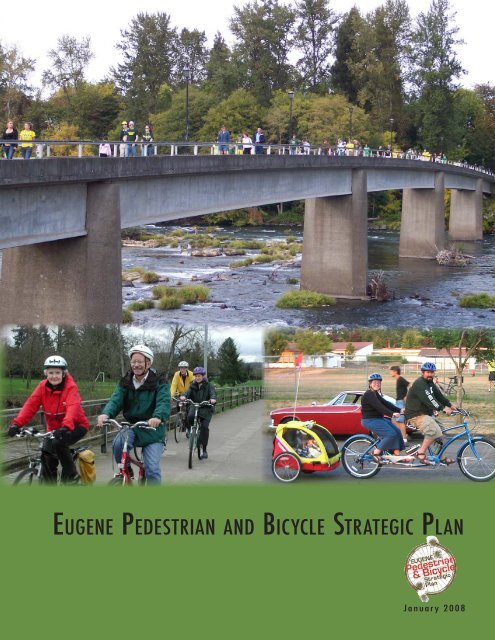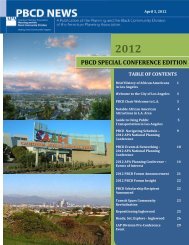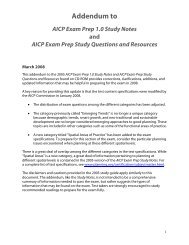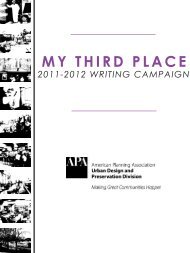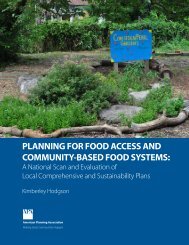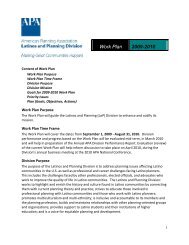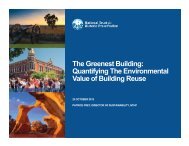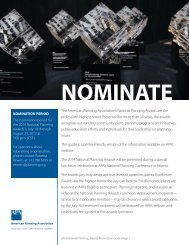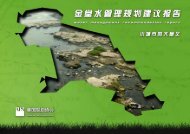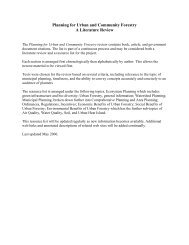eugene pedestrian and bicycle strategic plan - Scholars - University ...
eugene pedestrian and bicycle strategic plan - Scholars - University ...
eugene pedestrian and bicycle strategic plan - Scholars - University ...
- No tags were found...
You also want an ePaper? Increase the reach of your titles
YUMPU automatically turns print PDFs into web optimized ePapers that Google loves.
AcknowledgmentsThe creation of this <strong>plan</strong> has been a true community effort. We would not have been ableto create this <strong>plan</strong> without the support from all of those who attended the first Walking <strong>and</strong>Biking Summit, those who participated in the subsequent workshops, <strong>and</strong> those who submittedcomments <strong>and</strong> feedback on the draft <strong>plan</strong>.We would also like to extend our gratitude to those who served on the Department AdvisoryCommittee that guided the development of the <strong>plan</strong>:Michael Martin Elaine Rees Tyler BurgessSue Wolling Hans Kuhn Barbara NicholsSusan Stumpf Allen Heaman Bob KlineDavid Hinkley Katja Heide Ann JensenDave KlegerRonnel CurryDeveloped by:With support from:City of Eugene Transportation Planning TeamActing City Manager: Angel JonesRob Inerfeld Cindy Clarke Public Works Director: Kurt CoreyLee Shoemaker David Roth City Engineer: Mark SchoeningLindsay SelserCommunity Planning Workshop, <strong>University</strong> of OregonSarah Coates Tracy Rogan Andrea SparksMatt Peterson Joy Gipson Bethany JohnsonRyan Ojerio Ray Neff Bob ParkerPhotos: City of Eugene, Vern Rogers, <strong>and</strong> Community Planning WorkshopEmail: peoplepower@ci.<strong>eugene</strong>.or.uswww.<strong>eugene</strong>-or.gov/walkbikeU n i ver s i t y o f O r e g o n
ContentsI. Why Create a Plan? . . . . . . . . . . . . . . . . . . . . . . . . . . . . . . . . . . 5Purpose 5TransPlan <strong>and</strong> its relation to this Strategic Plan 7Related Plans 8Methodology 9II. What are Our Priorities? . . . . . . . . . . . . . . . . . . . . . . . . . . . . . 12Goals, Strategies <strong>and</strong> Actions . . . . . . . . . . . . . . . . . . . . . . . . . . . . . . . . . . . . . .13III. How do We Make it Happen? . . . . . . . . . . . . . . . . . . . . . . . . . 28Community Members <strong>and</strong> Organizations 28Bicycle <strong>and</strong> Pedestrian Advisory Committee (BPAC) 29Organization Acronyms <strong>and</strong> Contact Information for Strategies <strong>and</strong> Actions . . . .31Chapter Contents I.
I. Why Create a Plan?Eugene is a place where walking <strong>and</strong> biking are integral tothe community’s culture, where the city’s livability, sustainability <strong>and</strong> overallquality of life are enhanced by more people walking <strong>and</strong> biking, <strong>and</strong> wherethese activities are safe, convenient <strong>and</strong> practical options for everyone.Eugene has a history of thinking <strong>and</strong> acting boldly around walking <strong>and</strong>biking issues, <strong>and</strong> we want to continue that legacy. Our city has milesof off-street walking <strong>and</strong> biking paths <strong>and</strong> more bridges across theWillamette River for <strong>pedestrian</strong>s <strong>and</strong> cyclists than for cars. Although we dohave an extensive biking <strong>and</strong> walking infrastructure <strong>and</strong> numerous communitybiking <strong>and</strong> walking organizations, Eugene does not currently have a <strong>strategic</strong><strong>plan</strong> dedicated to getting more people out walking <strong>and</strong> biking. In fall 2006,the City of Eugene <strong>and</strong> the community embarked on this <strong>strategic</strong> <strong>plan</strong>ningprocess.PurposeThe goal of this 5-year Strategic Plan is to forge a path for Eugene to follow,in becoming a more walkable <strong>and</strong> bikeable city. This <strong>plan</strong> is not a regulatory<strong>plan</strong> <strong>and</strong> will not be adopted as policy by the Eugene City Council. Nor isit a capital improvement <strong>plan</strong> that details the cost of specific infrastructureimprovements. Instead, it is a guide for City staff, community members, <strong>and</strong>organizations to use as they work toward a common vision.Eugene currently has:• 5 bike/<strong>pedestrian</strong>bridges over theWillamette River• 81 miles of on-streetbike lanes• 33 miles of off-streetpaths• 21 miles of signedbike routes• 621 miles ofsidewalksI. Why Create a Plan?
To make this vision a reality, the <strong>plan</strong> identifies goals, strategies <strong>and</strong> actions thatare tangible <strong>and</strong> achievable within the next five years. Actions address not onlythe <strong>pedestrian</strong> <strong>and</strong> <strong>bicycle</strong> infrastructure but other elements that impact walking<strong>and</strong> biking – such as safety, education, encouragement <strong>and</strong> funding.This <strong>plan</strong> supports the community’s efforts toward addressing sustainability<strong>and</strong> the challenges of global climate change. A recent greenhouse gas inventoryidentified transportation as the single greatest source of greenhouse gas emissionsin Eugene. It furthers the community’s goals of equity - a truly walkable <strong>and</strong>bikeable city is more equitable because senior citizens, people with disabilities,<strong>and</strong> children <strong>and</strong> youth will have the same mobility opportunities as the drivingpopulation. Moreover, a walkable <strong>and</strong> bikeable city supports active lifestyles <strong>and</strong>will improve overall community health.The Plan is intended to be used in several ways:1) To involve the community in a concerted, structured effort to improve theexperience of walking <strong>and</strong> biking in Eugene;2) To guide City of Eugene Transportation Planning Team staff <strong>and</strong> otherCity staff in their work to make Eugene more walkable <strong>and</strong> bikeable; <strong>and</strong>3) To coordinate the activities <strong>and</strong> programs of many different organizations,non-profit agencies, <strong>and</strong> government agencies that promote walking <strong>and</strong>biking in Eugene.The <strong>plan</strong> is a tool to create new partnerships between community organizations,the City of Eugene, local businesses, <strong>and</strong> <strong>pedestrian</strong>s <strong>and</strong> bicyclists <strong>and</strong> builda more livable, active, sustainable, engaged <strong>and</strong> equitable city. Communitymembers have already demonstrated their commitment to the <strong>plan</strong>’s visionby actively participating in workshops, summits, <strong>and</strong> a departmental advisorycommittee. These next five years will be exciting as we work to make the visionof this <strong>plan</strong> a reality.NOTE: This <strong>plan</strong> uses the words walking <strong>and</strong><strong>pedestrian</strong> broadly. These terms include walking,running, skateboarding, rollerblading, <strong>and</strong> the use ofwheelchairs, mobility scooters, <strong>and</strong> other formsof non-motorized transportation.Biking includes the use of all forms of nonmotorized,wheeled transportation.
TransPlan <strong>and</strong> its relation to thisStrategic PlanTransPlan is the transportation component of theEugene-Springfield Metropolitan Area GeneralPlan (Metro Plan). Adopted in 2001, the policies inTransPlan are designed to support Metro Plan goals<strong>and</strong> l<strong>and</strong> use patterns by addressing transportation inthe metropolitan area.Specific <strong>pedestrian</strong> <strong>and</strong> <strong>bicycle</strong>-related policies withinTransPlan call for improving Eugene’s bikeway system,constructing bike lanes, increasing connectivity,implementing <strong>bicycle</strong> <strong>and</strong> shared-use facility projects,<strong>and</strong> constructing sidewalks on all new urban streets.Projects within TransPlan are updated periodically <strong>and</strong>as they are completed.The Pedestrian <strong>and</strong> Bicycle Strategic Plan is notdesigned to replace or be a substitute for TransPlan.TransPlan serves as the adopted Transportation SystemPlan for the city <strong>and</strong> is where infrastructure projectsthat benefit <strong>pedestrian</strong>s <strong>and</strong> bicyclists are identified<strong>and</strong> prioritized. Trans<strong>plan</strong> will continue to be thehome of future <strong>bicycle</strong> <strong>and</strong> shared use infrastructureproject lists. Future TransPlan updates will provideopportunities for public input on making changes tothe infrastructure project list.The purpose of the Pedestrian <strong>and</strong> Bicycle StrategicPlan is to take a comprehensive look at how Eugenecan become a more walkable <strong>and</strong> bikeable city.Developing walking <strong>and</strong> biking infrastructure is onlyone way to accomplish this vision. The City <strong>and</strong>community organizations must also look at education,marketing, <strong>and</strong> outreach to encourage people to usethe infrastructure.This Strategic Plan directly links to TransPlanthrough Strategy 4.2: Improve <strong>pedestrian</strong> <strong>and</strong> <strong>bicycle</strong>infrastructure connectivity. Within this strategy, Action4.2.3 calls for creating an implementation strategyfor TransPlan <strong>bicycle</strong> <strong>and</strong> <strong>pedestrian</strong> projects thatincludes early phases of project development <strong>and</strong>community outreach. The Bicycle <strong>and</strong> PedestrianAdvisory Committee (BPAC), developed as a result ofTransPlan Pedestrian & BicyclePolicies:Bikeway System <strong>and</strong> Support FacilitiesConstruct <strong>and</strong> improve the region’sbikeway system <strong>and</strong> provide <strong>bicycle</strong>system support facilities for both newdevelopment <strong>and</strong> redevelopment/expansion.Bikeways on Arterials <strong>and</strong> CollectorsRequire bikeways along new <strong>and</strong>reconstructed arterial <strong>and</strong> majorcollector streets.Bikeway Connections to New DevelopmentRequire bikeways to connect newdevelopment with nearby neighborhoodactivity centers <strong>and</strong> major destinations.Implementation of Priority Bikeway MilesGive funding priority (ideally withinthe first 3 to 5 years after adoption ofTransPlan subject to available funding)to st<strong>and</strong>-alone bikeway projects that areincluded in the definition of “PriorityBikeway Miles” <strong>and</strong> that increase theuse of alternative modes.Pedestrian EnvironmentProvide for a <strong>pedestrian</strong> environmentthat is well integrated with adjacentl<strong>and</strong> uses <strong>and</strong> is designed to enhancethe safety, comfort, <strong>and</strong> convenienceof walking.Continuous <strong>and</strong> Direct RoutesProvide for a continuous <strong>pedestrian</strong>network with reasonably direct travelroutes between destination points.SidewalksConstruct sidewalks along urban areaarterial <strong>and</strong> collector roadways, exceptfreeways.www.lcog.org/trans<strong>plan</strong>/Chapter I. Why Create I. a Plan?
this <strong>strategic</strong> <strong>plan</strong> will work with staff to prioritize projects listed in TransPlanfor implementation. This would provide for more public involvement than theCity currently has in determining which projects are constructed each year. Theadvisory committee would also likely take a leadership role in the <strong>pedestrian</strong> <strong>and</strong><strong>bicycle</strong> aspects of a future TransPlan update.Related PlansThe actions in this Strategic Plan are consistent with policies <strong>and</strong> guidance ofother <strong>plan</strong>s that relate to walking <strong>and</strong> biking in Eugene including:Oregon Transportation Plan (OTP)The OTP is the statewide set of policies, goals <strong>and</strong> strategies that addresses stateruntransportation systems <strong>and</strong> guides regional <strong>and</strong> local transportation system<strong>plan</strong>s. Under OTP are many separate <strong>plan</strong>s, such as the Oregon Pedestrian <strong>and</strong>Bicycle Plan, that provide more specific policy direction.Oregon Pedestrian <strong>and</strong> Bicycle PlanThe Oregon Department of Transportation (ODOT) published the OregonBicycle <strong>and</strong> Pedestrian Plan in 1995 <strong>and</strong> is in the process of revising the <strong>plan</strong>.This <strong>plan</strong> includes policies <strong>and</strong> st<strong>and</strong>ards that govern the design of walking <strong>and</strong>biking infrastructure. While these st<strong>and</strong>ards are applied to all state highwayprojects within ODOT’s jurisdiction, they are recommended but not requiredfor local jurisdictions.Arterial <strong>and</strong> Collector Street Plan (ACSP)Adopted in 1999, the ACSP describes specific policies <strong>and</strong> design st<strong>and</strong>ards thatapply to Eugene’s classified streets; it does not propose specific projects. UnlikeTransPlan, the ACSP applies only to the City of Eugene. Where roadways fallunder the jurisdiction of the county or the state, ACSP st<strong>and</strong>ardswill be advisory <strong>and</strong> not replace existing intergovernmentalagreements.Central Area Transportation Study (CATS)CATS was revised in 2004 <strong>and</strong> includes policies <strong>and</strong>implementation strategies for the <strong>pedestrian</strong> system <strong>and</strong> <strong>bicycle</strong>facilities in the downtown <strong>and</strong> surrounding area of Eugene. Itrecognizes the importance of making the central area of Eugeneaccessible to <strong>pedestrian</strong>s <strong>and</strong> cyclists.
MethodologyThe City of Eugene’s Department of Public Works Transportation Planning Teamdeveloped this Strategic Plan using a dynamic community engagement process,with advice <strong>and</strong> guidance from a Departmental Advisory Committee (DAC).There were 14 members of the DAC, which included representatives from:• Eugene Bicycle Coalition• Walk With Me• Paul’s Bicycle Way of Life• AAA (American Automobile Association)• Friends of Eugene• Burley Design• LCHAY (Lane Coalition for Healthy <strong>and</strong> Active Youth)• The Accessibility Committee of the Human Rights Commission• GEARs (Greater Eugene Area Riders)• Neighborhood Associations (Friendly, Harlow)• The general communityChapter I. Why Create I. a Plan?
The City contracted with the <strong>University</strong> of Oregon’s Community PlanningWorkshop (CPW) to help facilitate the <strong>strategic</strong> <strong>plan</strong>ning process, includingresearch, writing, <strong>and</strong> conducting public outreach.The extensive public engagement process included:Eugene Walking <strong>and</strong> Biking Summit (approximately 225 participants):This well-attended <strong>and</strong> highly successful event kicked off the <strong>strategic</strong><strong>plan</strong>ning process. The summit included speakers, seven panel discussions, <strong>and</strong>twelve community input sessions. These input sessions were the beginningof the community’s involvement in creating a vision for a more walkable <strong>and</strong>bikeable Eugene. The input sessions also solicited feedback about the issues<strong>and</strong> obstacles facing the community in trying to achieve this vision.Community Workshops:• Bicycle Theft <strong>and</strong> Bicycle Parking – Jan. ‘07 (approximately 40participants): This workshop included presentations from the EugenePolice Department <strong>and</strong> Department of Public Works about bike theft <strong>and</strong>parking, as well as breakout sessions for community members to discuss <strong>and</strong>brainstorm strategies <strong>and</strong> actions to address <strong>bicycle</strong> theft <strong>and</strong> parking.• Seniors <strong>and</strong> Accessibility – Feb. ‘07 (approximately 30 participants): Thisworkshop provided opportunities for community members to raise keyissues relating to seniors <strong>and</strong> accessibility, <strong>and</strong> discuss solutions to theseissues.• Youth – March ‘07 (approximately 90 participants): CPW conductedin-class exercises with middle school students to gather input about walking<strong>and</strong> biking issues, preferences <strong>and</strong> concerns particular to them, especiallyyouth safety <strong>and</strong> education.• Visual Design Preference – April ‘07 (approximately 40 participants):CPW <strong>and</strong> the Department of Public Works presented images of differentwalking <strong>and</strong> biking infrastructure <strong>and</strong> amenities tocommunity participants <strong>and</strong> asked them to rate theirlevel of comfort <strong>and</strong> safety with each design element.• Education <strong>and</strong> Encouragement – May ‘07(approximately 25 participants): In small breakoutgroups, this workshop gave community membersthe opportunity to suggest specific education <strong>and</strong>outreach activities designed to support the goals ofthis <strong>strategic</strong> <strong>plan</strong>.10
City of Eugene Department Input Sessions (staff participants fromdepartments <strong>and</strong> divisions across the City organization): Over a twomonthperiod, the Transportation Planning Team met with representativesfrom City divisions, departments <strong>and</strong> teams to solicit input aboutobstacles to walking <strong>and</strong> biking <strong>and</strong> generate strategies to address them.Later, two additional meetings were held with about 40 staff fromdifferent City departments to get their feedback on the draft <strong>plan</strong>.Stakeholder Interviews (19 interviewees): CPW conducted in-depthinterviews with community leaders <strong>and</strong> experts on issues related towalking <strong>and</strong> biking.CPW <strong>and</strong> the City’s Transportation Planning Team organized <strong>and</strong> synthesizedthe information gathered through the summit, workshops, input sessions, <strong>and</strong>interviews into the vision, goals, strategies <strong>and</strong> actions of this Plan. The DACplayed a key role by providing guidance <strong>and</strong> advice to help sort through <strong>and</strong>prioritize the information gathered through the public engagement process.Chapter I. Why Create I. a Plan?11
II. What are Our Priorities?This Strategic Plan articulates an overarching vision for the community<strong>and</strong> provides a concrete, specific <strong>plan</strong> of action that will empower <strong>and</strong>guide the community toward this vision. It is a dynamic <strong>plan</strong> that relieson broad community participation.12VisionEugene is a place wherewalking <strong>and</strong> biking areintegral to thecommunity’s culture,where the city’slivability, sustainability<strong>and</strong> overall quality of lifeare enhanced bymore peoplewalking <strong>and</strong> biking,<strong>and</strong> where these activitiesare safe, convenient<strong>and</strong> practical optionsfor everyone.GoalsThis <strong>strategic</strong> <strong>plan</strong> has four parts:• Vision: The vision statement concisely describes a futureEugene in which walking <strong>and</strong> biking are more fully integratedinto the life of the city. Attaining this vision will requirea strong commitment by individuals <strong>and</strong> organizationsthroughout the community, <strong>and</strong> a significant investment oftime <strong>and</strong> resources.• Goals: The five goals address issues of community culture,encouragement, safety, accessibility <strong>and</strong> connectivity, <strong>and</strong>implementation <strong>and</strong> funding.• Strategies: The seventeen strategies provide a conceptualframework or method for how the goals can be achieved.• Actions: This <strong>plan</strong> has 82 specific, assignable actionsfor implementing the strategies. To help guide theimplementation of the <strong>plan</strong>, the DAC, City staff, <strong>and</strong> thecommunity prioritized the actions.** NOTE: This <strong>plan</strong> is intended to serve as a guide to action bythe City, other agencies, <strong>and</strong> the community. It does not obligatethe City or any other entity or person to implement any action.It is expected that as time <strong>and</strong> budgets allow, the feasibility ofindividual actions will be considered for implementation.Goal 1: Foster <strong>and</strong> develop a community culture supportive of walking <strong>and</strong>biking as important modes of transportation <strong>and</strong> recreation.Goal 2: Increase the share of trips people make by walking <strong>and</strong> biking fortransportation <strong>and</strong> recreation.Goal 3: Increase safety for bicyclists, <strong>pedestrian</strong>s, <strong>and</strong> motorists.Goal 4: Create accessible, efficient <strong>and</strong> convenient methods for <strong>pedestrian</strong>s<strong>and</strong> bicyclists to travel to the places where they live, work, <strong>and</strong> play.Goal 5: Build productive partnerships <strong>and</strong> obtain stable <strong>and</strong> diverseresources to sufficiently implement <strong>and</strong> promote the <strong>plan</strong>.
Goals, Strategies <strong>and</strong> ActionsEach goal of this <strong>strategic</strong> <strong>plan</strong> has several strategies that will help to achieve that particular goal.Each strategy has a unique set of specific actions that, when implemented, will help make thevision a reality. The strategies <strong>and</strong> actions are displayed in a matrix beginning on page 14.The matrix of strategies <strong>and</strong> actions also includes information useful for implementation of eachaction. There are columns that identify lead <strong>and</strong> partner organizations, the priority of the action,<strong>and</strong> the level of resources needed for implementation.Analysis of an Action Item:Lead Organizations: The organizations responsible for implementation of the action. A list of allthe acronyms <strong>and</strong> the organizations they represent is included on page 31.Partner Organizations: Organizations assisting with implementation.Priority: All of the actions in this <strong>plan</strong> are important <strong>and</strong> contribute to achieving the vision.However, each action has been given a priority based on feedback from the DAC, City staff,<strong>and</strong> the community to help guide implementation efforts. The priority is based not just onimportance, but also on cost, ease of implementation, <strong>and</strong> whether the action is already occurring.There are five levels of priority:★ ★ ★ ★ ★ (highest)★ ★ ★ ★ (higher)★ ★ ★ (medium)★ ★ (lower)★ (lowest)Resources: This column illustrates the amount of resources needed to implement each action item.This <strong>plan</strong> considers both time <strong>and</strong> money as resources. The measures do not have specific valuesbut are relative estimates as compared to other actions within the <strong>plan</strong> <strong>and</strong> are represented as:uuu (high)uu (medium)u (low)This allows City staff <strong>and</strong> community organizations to quickly identify those action items that areresource intensive <strong>and</strong> those that are not. Costing out each action item was outside the scope ofthis project for various reasons:(1) the cost of specific infrastructure improvements will be itemized in the City’s capitalimprovement <strong>plan</strong>s (CIPs), not the Strategic Plan; <strong>and</strong>(2) some of the action items will be completed by community organizations <strong>and</strong> it is unclearexactly how they will be implemented, thus an exact cost can not be assigned.Chapter II. What I. are Our Priorities?13
1Foster a community culture supportive ofwalking <strong>and</strong> biking as important modes oftransportation <strong>and</strong> recreation.This goal looks beyond the physical infrastructure of Eugene to include strategies <strong>and</strong>actions that will make walking <strong>and</strong> biking an integral part of Eugene’s culture. Thesestrategies <strong>and</strong> actions support efforts that will increase the community’s exposure towalking <strong>and</strong> biking.1.1 Encourage walking <strong>and</strong> biking to community events.1.1.1Ensure <strong>bicycle</strong> parking is available at majorcommunity events.1.1.2Develop images <strong>and</strong> slogans that publicize<strong>bicycle</strong> <strong>and</strong> <strong>pedestrian</strong> friendly events <strong>and</strong>integrate them into event marketing.lead partners priority resourcesCAT, LRCS,PWE/TPLRCS, PWE/TP20/30 Club,UO, PW/POS★ ★ ★★uPIT ★ ★ u1.2 Support creative local walking <strong>and</strong> biking events.1.2.1Organize signature walking <strong>and</strong> biking eventsat the citywide <strong>and</strong> neighborhood level.1.2.2Evaluate current permitting process forbicycling, running <strong>and</strong> walking events.Identify methods of encouraging these activecommunity events.1.2.3Conduct an annual <strong>University</strong> of OregonTransportation Fair that emphasizes walking,biking, <strong>and</strong> transit.lead partners priority resourcesGEARs/EBCPWE/PIC,PWE/TP, EPDUOPWM/TO,RunningStores,PWE/TPOBRA,CVALCO,PW/POS,LRCS,PWM/TO★ ★ ★★★ ★★uuuuu14
1.3 Strengthen local walking <strong>and</strong> biking organizations.lead partners priority resources1.3.1Promote local walking <strong>and</strong> bikingorganizations through the City’s website <strong>and</strong>publications.1.3.2Offer trainings on the topics of leadership,voluteerism, advocacy, marketing, websitedevelopment, <strong>and</strong> membership recruitment.PWE/TP,LRCS,PW/POS★ ★ ★uBTA ★ ★ u1.4 Promote <strong>and</strong> introduce Eugene as a walkable, bikeable, <strong>and</strong> accessible city.lead partners priority resources1.4.1Integrate walking <strong>and</strong> biking into other Cityinitiatives, specifically sustainability <strong>and</strong>accessibility.1.4.2Promote Eugene as a walkable <strong>and</strong> bikeablecity to new residents <strong>and</strong> incoming universitystudents. Create a <strong>plan</strong> to develop <strong>and</strong>distribute walking <strong>and</strong> biking materials totargeted prospective residents.1.4.3Seek recognition for Eugene as a great city forwalking <strong>and</strong> biking.1.4.4Promote the use of <strong>bicycle</strong>s for work useamong City employees <strong>and</strong> clearly identify<strong>bicycle</strong>s in the City’s fleet as City of Eugenebikes.1.4.5Create a <strong>plan</strong> to distribute walking, biking,<strong>and</strong> transit materials to area lodging <strong>and</strong>tourist destinations <strong>and</strong> provide thisinformation on websites targeted to visitors.1.4.6Promote transit-connected recreationopportunities through brochures, webmarketing, <strong>and</strong> special events.SustainabilityCommission,HRC/ACPWE/TP,UO, LCC,NCCChamber ofCommerce,CVALCO★ ★ ★★★ ★ ★uuPIT, PWE/TP ★ ★ ★ uPWE/TPCVALCOPWE/TPLTD/CSSustainability★ ★ ★CommissionuUO, Eugene★ ★AirportuCVALCO,LRCS, PW/POS, EugeneAirportNote: For a list of acronyms <strong>and</strong> contact information, see page 31.★uChapter Goals, Strategies I. <strong>and</strong> Actions15
2Increase the share of tripsmade by walking <strong>and</strong> biking.2.1 Develop programs that encourage people to shift from driving to walking <strong>and</strong>biking for short trips.Approximately 51% of car trips in Eugene are less than 3 miles <strong>and</strong> 16% are less than1 mile. Trips of these distances are potential walking <strong>and</strong> biking trips. Shifting frommotor vehicle use to walking <strong>and</strong> biking can help the community address obesity <strong>and</strong>related health problems, decrease carbon emissions, reduce congestion on our roads,<strong>and</strong> further our efforts toward sustainability.lead partners priority resources2.1.1Develop a comprehensive Safe Routes toSchool program that works with at least onenew school every year.2.1.2Develop a media campaign to promotewalking <strong>and</strong> biking as viable means oftransportation.2.1.3Support continuation <strong>and</strong> expansion ofBTA bike education programs in middleschools.2.1.4Develop an individualized marketingprogram that targets a different geographicarea every year.2.1.5Continue holding the annual BusinessCommute Challenge.2.1.6Develop an integrated program toencourage more UO students to walk <strong>and</strong>bike.BTA, LTD/CSPWE/TP,LTD/CS4J/Bethel, BTAPWE/TP,LTD/CSPWE/TPPWE/TP, EPD,PWM, LRCS,Bike Shops,CAT, LCHAY,4J/Bethel,PrivateSchools, PW/POS, PTOs,NA , ODOTCLI, PIT,ODOTEBC, LCHAYEBC, CLI, BikeShops, CAT,NAsLTD/CS,Peace Health,Chamber ofCommerce★ ★ ★★ ★★ ★ ★★★ ★ ★★★ ★ ★★ ★ ★uuuuuuuuuuuUO ★ ★ ★ uu16
lead partners priority resources2.1.7Increase the number of schools thatparticipate in International Walk to SchoolDay.2.1.8Encourage employers to provide incentives<strong>and</strong> accommodations to employees whowalk or bike to work.2.1.9Develop an ongoing safe cycling educationprogram for adults.2.1.10Educate businesses about why it isimportant to be bike-friendly <strong>and</strong> providerecognition of those that are.2.1.11Develop a program to encourage seniorsto walk <strong>and</strong> bike, <strong>and</strong> that includeseducational <strong>and</strong> organized activities.LTD/CSLTD/CS ,PWE/TPBTA,GEARs/ EBCGEARs/EBCLRCS,PWE/TP4J/Bethel,PrivateSchools, PTOsGEARs/EBC,Chamber ofCommerce,CLI★ ★ ★★ ★ ★uuPWE/TP ★ ★ ★ uCLI, Chamber★ ★of CommerceuEBC, BikeShops, CAT,RunningStores★u2.2 Advocate for mixed-use development in new <strong>and</strong> existing neighborhoodsMixed-use development is the official growth management policy of the City of Eugene,<strong>and</strong> TransPlan identifies dozens of potential mixed-use centers (MUCs) around town.MUCs are <strong>pedestrian</strong> friendly <strong>and</strong> transit oriented; they include a combination ofhousing, commercial <strong>and</strong> retail areas in close proximity to each other <strong>and</strong> in higherdensities than traditional development, making walking <strong>and</strong> biking more convenient.lead partners priority resources2.2.1Advocate for mixed-use development inEugene at both the neighborhood <strong>and</strong> citywidescales.2.2.2Provide educational opportunities for thegeneral public about the benefits of mixeduse centers <strong>and</strong> compact development, <strong>and</strong>how they encourage bicycling <strong>and</strong> walkingtransportation.GEARs,LCHAYGEARsEBC, AIA ★ ★ ★ uEBC, LCHAY,PWE/TP,PDD/PLNote: For a list of acronyms <strong>and</strong> contact information, see page 31.★ ★ ★uChapter Goals, Strategies I. <strong>and</strong> Actions17
2.3 Reduce <strong>bicycle</strong> theft.In 2006, over 750 bikes were reported stolen to the Eugene Police Department <strong>and</strong>the <strong>University</strong> of Oregon’s Department of Public Safety; many more stolen bikesgo unreported. To some, the threat of bike theft is a deterrent to the use of bikes forcommuting, running err<strong>and</strong>s, <strong>and</strong> general travel around Eugene.lead partners priority resources2.3.1Create a working group focused on ways toreduce bike theft.2.3.2Educate UO, LCC, <strong>and</strong> NCC students <strong>and</strong>other <strong>bicycle</strong> users about how to securetheir bikes properly.2.3.3Work with <strong>bicycle</strong> retail <strong>and</strong> repair shops toimplement consistent <strong>and</strong> effective <strong>bicycle</strong>registration at point of sale. Consider usingelectronic or on-line registration methods.2.3.4Promote the use of the most effective <strong>bicycle</strong>locks <strong>and</strong> security techniques.2.3.5Provide information about how to lock your<strong>bicycle</strong> with every <strong>bicycle</strong> purchase.PWE/TP, EPDPWE/TP, UO,LCC, NCCEPD, UOPWE/TP, BikeShops, CATUO,Prosecutor’sOffice/MunicipalCourt, BikeShops, CAT★ ★ ★★uBike Shops,★ ★ ★CATuPWE/TP, Bike★ ★Shops, CATuuUO ★ uPWE/TP, Bike★Shops, CATu18
3Increase safety for bicyclists, <strong>pedestrian</strong>s,<strong>and</strong> motorists.3.1 Effectively enforce laws that affect bicyclist <strong>and</strong> <strong>pedestrian</strong> safety.Effective enforcement of laws that protect the safety of others can help addressconflicts between motorists, cyclists, <strong>and</strong> <strong>pedestrian</strong>s.lead partners priority resources3.1.1Develop a program to educate <strong>pedestrian</strong>s,bicyclists, <strong>and</strong> motorists about crosswalklaws <strong>and</strong> conduct enforcement asappropriate.3.1.2Develop legislative strategy for addressing<strong>pedestrian</strong> <strong>and</strong> <strong>bicycle</strong> safety issues at thestate level.3.1.3Work with Police Department to developshared underst<strong>and</strong>ing of safety issues<strong>and</strong> laws that pertain to <strong>pedestrian</strong>s <strong>and</strong>bicyclists.3.1.4Enforce “no parking of automobiles” inbike lanes <strong>and</strong> on sidewalks.3.1.5Examine reasons for riding bikes ondowntown sidewalks <strong>and</strong> work toameliorate the problem through aneducation campaign <strong>and</strong> accompanyingenforcement.3.1.6Re-examine the “no bikes on sidewalks”zone for possible expansion.EPD, PWE/TPPWE/TPPWM/TOBTA, COE-IGR, EPD,GEARs/EBC★ ★ ★★★ ★ ★★uuuPWE/TP, EPD EBC/GEARs ★ ★ ★ uPDD/PS EPD ★ ★ ★ uDEI, EPDPWE/TP,★ ★PWMuuDEI, PWE/TP EPD ★ uuNote: For a list of acronyms <strong>and</strong> contact information, see page 31.Chapter Goals, Strategies I. <strong>and</strong> Actions19
3.2 Ensure that the <strong>pedestrian</strong> <strong>and</strong> <strong>bicycle</strong> system is safe <strong>and</strong> functional for all users.Well designed infrastructure is only as useful as its level of upkeep. Well maintainedinfrastructure is vital not only for protecting the safety of <strong>pedestrian</strong>s <strong>and</strong> cyclists,but also for ensuring accessibility to all. The City can enhance its efforts byincluding community involvement <strong>and</strong> relying on user feedback.lead partners priority resources3.2.1Keep <strong>pedestrian</strong> <strong>and</strong> <strong>bicycle</strong> ways clearof leaves, vegetation, construction signs,<strong>and</strong> other obstructions. Re-examine <strong>and</strong>consider making changes to City’s leafdisposal program.3.2.2Install additional street lighting whereneeded at conflict points, at crosswalks,on sidewalks, <strong>and</strong> along shared use paths.Develop criteria for prioritizing lightinginvestments.3.2.3Develop additional tools for enhancing<strong>pedestrian</strong> <strong>and</strong> <strong>bicycle</strong> street crossings—both mid-block <strong>and</strong> at intersections.3.2.4Establish clear <strong>pedestrian</strong> <strong>and</strong> <strong>bicycle</strong>detours during construction.3.2.5Enforce sidewalk maintenancerequirements.3.2.6Address conflicts between <strong>pedestrian</strong>s <strong>and</strong>autos at double turn lanes.3.2.7Create a process for the communityto identify unsafe (maintenance <strong>and</strong>facilities) locations <strong>and</strong> suggest site-specificimprovements.3.2.8Enforce the leash law.PWM,PW/POS,CS/F, PWEPWE/TP,PWM/TO,PW/POS,PDD/PL, CS/FPWE,PWM/TOPWE, PWMPWE/TPEPD★ ★ ★★ ★★ ★ ★★★ ★ ★★★ ★ ★★uuuuuuuuuuPWM ★ ★ ★ uuuPWE/TP,★ ★ ★PWE/TOuuPWE/TP,★ ★ ★PWE/TOuuAnimalControlEPD ★ u20
3.3 Conduct outreach <strong>and</strong> education to increase safety <strong>and</strong> awareness for<strong>pedestrian</strong>s, bicyclists <strong>and</strong> motorists.It is common for <strong>pedestrian</strong>s, bicyclists <strong>and</strong> motorists to complain about the behaviorof people using other modes of transportation. Effective education <strong>and</strong> outreachprograms must focus on teaching everyone how to be safe <strong>and</strong> respectful of others,<strong>and</strong> themselves, as they walk, bike or drive.3.3.1Develop <strong>and</strong> launch a Share the Roadmedia <strong>and</strong> education campaign targetedto motorists, bicyclists <strong>and</strong> <strong>pedestrian</strong>s.3.3.2Educate bicyclists <strong>and</strong> <strong>pedestrian</strong>s abouthow to safely use shared use paths,sidewalks, <strong>and</strong> hiking trails.3.3.3Provide free <strong>and</strong> low-cost safetyequipment (helmets, lights, bells) <strong>and</strong><strong>bicycle</strong> repair to people in need.lead partners priority resourcesPWE/TP,PIT, AAA,ElectedOfficialsGEARs/EBC,PWE/TP,PW/POSPWE/TP,LTD,MedicalProvidersEPD, BTA, ODOT,GEARs/EBC, AutoInsurers, Bike Shops,CAT, UO/DPS, LCC,NCC, 4J/Bethel,Private SchoolsHRC/AC, LCMBA,Bike Shops, CAT,PWMGEARs/EBC, EPD,Fire/EMS, BikeShops, CAT★ ★ ★★ ★★ ★★ ★uuuuuuuNote: For a list of acronyms <strong>and</strong> contact information, see page 31.Chapter Goals, Strategies I. <strong>and</strong> Actions21
4Create accessible, efficient <strong>and</strong> convenientmethods for <strong>pedestrian</strong>s <strong>and</strong> bicyclists totravel to the places where theylive, work, <strong>and</strong> play.4.1 Ensure that <strong>pedestrian</strong> <strong>and</strong> <strong>bicycle</strong> facilities are accessible to everyone in thecommunity.An accessible community is one where people of all different abilities are able to getaround. Currently, there are places within the transportation system that are lackingthe facilities <strong>and</strong> infrastructure that enable everyone to move around safely.lead partners priority resources4.1.1Continue to retrofit curb ramps <strong>and</strong> installnew curb ramps at intersections.PWM, PWE★ ★ ★★uuu4.1.2Continue to add audible <strong>pedestrian</strong> signalsto existing traffic signals throughoutEugene.4.1.3Increase the City st<strong>and</strong>ard bike lane widthto 6-feet.4.1.4Hold an annual barrier awareness dayto educate the community about theimportance of infrastructure that isaccessible to everyone.4.1.5Promote the City’s Adaptive RecreationProgram.PWM/TO,HRC/AC,PWE★ ★ ★uuuPWE/TP,★ ★PWM, PWEuuHRC/AC ★ ★ uLRCS PWE/TP ★ ★ u22
4.2 Improve <strong>pedestrian</strong> <strong>and</strong> <strong>bicycle</strong> infrastructure connectivity.Eugene has an extensive system of off-street shared use paths, on-street stripedbike lanes, <strong>and</strong> sidewalks. Each of these elements is an integral piece of the overalltransportation system <strong>and</strong> network. One of the greatest challenges to the effectiveness<strong>and</strong> functionality of these elements are gaps that reduce connectivity within thesystem. Our local Transportation System Plan (TSP) called TransPlan identifies <strong>bicycle</strong><strong>and</strong> shared-use facilities that would increase connectivity throughout Eugene. Theactions listed below call for developing an implementation strategy with input from a<strong>bicycle</strong> <strong>and</strong> <strong>pedestrian</strong> advisory committee for TransPlan projects.lead partners priority resources4.2.1Develop new bike boulevards <strong>and</strong> improveexisting bike boulevards, especially wherethey cross busy streets.4.2.2Re-initiate the sidewalk infill program to fillin gaps in the sidewalk system.4.2.3Create an implementation strategyfor TransPlan <strong>bicycle</strong> <strong>and</strong> <strong>pedestrian</strong>projects that includes project scoping <strong>and</strong>community outreach.4.2.4Examine <strong>and</strong> improve the interface oftransit with <strong>pedestrian</strong>s <strong>and</strong> cyclists. Thisincludes <strong>bicycle</strong> parking facilities, on-board<strong>bicycle</strong> storage, transit stop design <strong>and</strong>compatibility with surrounding streetscape.4.2.5Encourage businesses <strong>and</strong> organizations toprovide connections to bike paths.PWE/TP,PWM/TOPWE, PW/PIC,PWMPWE/TPHRC/ACPW/POS★ ★ ★★ ★★ ★ ★★★ ★ ★★uuuuuuuuPWE/TP, LTD ★ ★ ★ uuPWE/TP,PW/PICGEARs/EBC,★ ★PW/POSuNote: For a list of acronyms <strong>and</strong> contact information, see page 31.Chapter Goals, Strategies I. <strong>and</strong> Actions23
4.3 Ensure high quality, flexible <strong>and</strong> secure <strong>bicycle</strong> parking at all destinations.The City of Eugene requires new development to include bike parking in mostsituations. However, these regulations do not always meet the needs of bicyclists;often, there are not enough parking spots or the facilities are poorly designed <strong>and</strong>bikes are not secure.lead partners priority resources4.3.1Install more bike parking at City parks <strong>and</strong>facilities downtown, in <strong>pedestrian</strong>-scalebusiness districts, <strong>and</strong> in the public rightof-way.PWE/TP, CS/F,PW/POSPDD/PS★ ★ ★★ ★uu4.3.2Evaluate how effective the City Codeis at providing an adequate number ofwell placed <strong>and</strong> designed bike parkingspaces as part of redevelopment <strong>and</strong> newdevelopment. If it is determined that thereare problems with the Code, launch aneffort to amend it.4.3.3Develop a public outreach campaign toeducate business owners about the benefitsof maintaining sufficient bike parking fortheir customers. Include incentives forbringing inadequate parking up to code interms of quantity <strong>and</strong> design.4.3.4Provide an appropriate amount of bikeparking at public schools in Eugene.4.3.5Install more covered, long-term bikeparking for residents <strong>and</strong> employees indowntown Eugene.4.3.6Streamline <strong>and</strong> simplify the process(permitting, parking facility design <strong>and</strong>location, <strong>and</strong> construction) for businesseswishing to install <strong>bicycle</strong> parking in thepublic right-of-way in downtown <strong>and</strong> other<strong>pedestrian</strong>-scale business districts.4.3.7Develop a step-by-step guide to City <strong>bicycle</strong>parking requirements.PWE/TP,PDD/BPSGEARs/EBCGEARs/EBCPWE/TP★ ★ ★★ ★★ ★ ★★uuuu4J/Bethel,★ ★ ★PWE/TPuuuPWE/TP,PDD/PSPWE/TP,PW/PIC,PDD/BPSPWE/TPDEI ★ ★ ★ uuu★ ★ ★uPW/PIC,★ ★PDD/BPSu24
4.4 Provide easily accessible information about the <strong>pedestrian</strong> <strong>and</strong> <strong>bicycle</strong> system.A goal of this <strong>plan</strong> is to increase the number of people walking <strong>and</strong> biking in Eugene.All of these new walkers <strong>and</strong> bikers need to know how to get to their destination<strong>and</strong> back safely <strong>and</strong> efficiently if they are going to continue to walk <strong>and</strong> bike. Therealready is a bike map <strong>and</strong> a few directional signs, but generally this information isdifficult to find. The more obvious <strong>and</strong> easy to access the information is, the morelikely it will be used.lead partners priority resources4.4.1Develop a city-wide directional bike signagesystem that includes times, distances, <strong>and</strong>destinations.4.4.2Create a new sign type that directs<strong>pedestrian</strong>s <strong>and</strong> bicyclists to neighborhoodaccess ways (these are the short-cuts thatare often found at the end of cul-de-sacs).Develop a <strong>plan</strong> for installing these signsaround the City.4.4.3Enhance the City’s <strong>bicycle</strong> map <strong>and</strong>distribute it broadly throughout thecommunity. Enhancements should includeinformation about bike repair <strong>and</strong> rentals.4.4.4Develop an on-line <strong>pedestrian</strong> <strong>and</strong> <strong>bicycle</strong>trip <strong>plan</strong>ning feature on the City’s website.4.4.5Install a comprehensive system of kioskswith bikeway maps along paths, bikeboulevards <strong>and</strong> other locations popularwith bicyclists.PWE/TP,PW/POS,PWM/TO★ ★ ★uuuPWE/TP,★ ★PWM/TOuuuPWE/TP ★ ★ uuPWE/TP ★ ★ uuPWE/TP,PW/POS,PWM/TO★uuuNote: For a list of acronyms <strong>and</strong> contact information, see page 31.Chapter Goals, Strategies I. <strong>and</strong> Actions25
5Build productive partnerships <strong>and</strong>obtain stable <strong>and</strong> diverse resources tosufficiently implement <strong>and</strong>promote the Plan.5.1 Strategically implement the actions of this <strong>plan</strong> <strong>and</strong> monitor <strong>and</strong> evaluate progress.Effective <strong>strategic</strong> <strong>plan</strong>ning requires a deliberate process to gauge the implementationof actions designed to change current conditions. The <strong>pedestrian</strong> <strong>and</strong> <strong>bicycle</strong> <strong>strategic</strong><strong>plan</strong>ning process has covered the first two steps in this four-step process—first, creatingan inventory of existing conditions <strong>and</strong> second, identifying needs or deficiencies inthe system. Actions listed under this strategy call for developing the third <strong>and</strong> forthsteps of the process—setting benchmarks <strong>and</strong> developing a method for overseeingimplementation. Each of these tasks will be carried out through a collaborative effortbetween City staff <strong>and</strong> the Bicycle <strong>and</strong> Pedestrian Advisory Committee (BPAC).lead partners priority resources5.1.1Develop <strong>and</strong> staff an advisory committeethat regularly monitors, assists with, <strong>and</strong>advocates for implementation of the Plan.PWE/TP★ ★ ★★ ★uuu5.1.2Develop benchmarks <strong>and</strong> collect associateddata to determine the impact of <strong>plan</strong>implementation.5.1.3Publish <strong>and</strong> disseminate an annual reportto share <strong>plan</strong> progress with the community.Provide the annual report to the City Council.PWE/TPUO★ ★ ★★uuPWE/TP★ ★ ★★u5.2 Cultivate collaborative relationships among community organizations <strong>and</strong> theCity to support Plan implementation.To be successful, this <strong>plan</strong> relies on the active support <strong>and</strong> involvement of the Cityof Eugene as well as the broader community. Building partnerships <strong>and</strong> encouragingcommunity input will help strengthen this <strong>plan</strong> by utilizing the ideas, dedication, <strong>and</strong>support of the entire community to implement individual actions.lead partners priority resources5.2.1Organize an annual Walking <strong>and</strong> BikingSummit to both track <strong>and</strong> celebrate progressof the Plan <strong>and</strong> develop stronger relationshipsamong walking <strong>and</strong> biking advocates.PWE/TPGEARs/EBC,LCHAY,4J/Bethel, UO★ ★ ★u26
lead partners priority resources5.2.2Provide opportunities for people to learnabout the Plan <strong>and</strong> how to get involvedin implementation activities. Reach outto neighborhood associations <strong>and</strong> otherorganizations as part of this work.5.2.3Integrate elements of the Plan into theobjectives of other City initiatives such asthe Sustainability Commission, GreatestCity of the Arts <strong>and</strong> Outdoors, etc.5.2.4Cultivate support of walking <strong>and</strong> bikingamongst City leadership.PWE/TP HRC/AC, NAs ★ ★ ★ uSustainabilityCommission,HRC/ACCity Executive,Managers,Senior Mgmt.★ ★ ★★ ★ ★uu5.3 Proactively seek diversified financial resources to implement the Strategic Plan.Implementation of some actions will be costly <strong>and</strong> will require significant resources, howeverpartnerships <strong>and</strong> collaborative efforts are often able to attract funding at higher levels thanthe sum of their individual efforts. Like any transportation system, the construction <strong>and</strong>maintenance of high-quality <strong>pedestrian</strong> <strong>and</strong> <strong>bicycle</strong> infrastructure faces increasingly scarcefunding <strong>and</strong> competing interests. Although the City of Eugene already spends a significantportion of its transportation dollars on <strong>bicycle</strong> <strong>and</strong> <strong>pedestrian</strong> related projects, additionalfunding will be required for implementation of some actions within the <strong>plan</strong>.lead partners priority resources5.3.1Apply for grants <strong>and</strong> seek other contributionsto fund implementation items in the Plan.PWE/TP,GEARs/EBC★ ★ ★★ ★u5.3.2Develop exp<strong>and</strong>ed <strong>and</strong>/or new fundingstreams to support ongoing activities thatare part of Plan implementation.5.3.3Develop funding stream to maintain theped/bike system at a high level of service.Prioritize elements of the system to bemaintained at a high level, depending onfunding that is ultimately available.5.3.4Develop priorities for Plan implemenationwithin financial constraints.5.3.5Organize one or more annual fundraisingevents to support items in the Plan.PW DirectorPWM,PW/POSPWE/TP★ ★ ★★★ ★ ★★★ ★ ★★uuuuuuuGEARs/EBC ★ ★ uuChapter Goals, Strategies I. <strong>and</strong> Actions27
III. How do We Make it Happen?The goals, strategies <strong>and</strong> actions of this <strong>plan</strong> provide a framework to helpEugene achieve its vision for walking <strong>and</strong> biking. It is a true communitybased <strong>plan</strong> – it was formed out of extensive public outreach <strong>and</strong> itssuccess relies on community organizations, as well as the City of Eugene, takingresponsibility for implementing action items.To keep the Plan active in the community, four key components are necessary:(1) Strong leadership to ensure that the efforts being implemented are inline with the goals of the <strong>plan</strong> <strong>and</strong> that activity progresses.(2) Community involvement in implementing items in the <strong>plan</strong>.(3) Systematic monitoring to track progress of <strong>plan</strong> implementation <strong>and</strong>help identify needed changes to the <strong>plan</strong>.(4) Update after five years to ensure that the <strong>plan</strong> is congruent with theneeds of the community.This section describes the structure <strong>and</strong> process to ensure successful <strong>plan</strong>implementation <strong>and</strong> monitoring. This structure is composed of three main parts:• Community Members <strong>and</strong> Organizations;• A Bicycle <strong>and</strong> Pedestrian Advisory Committee (BPAC);• Committee Staff Coordinator.Each of these components is described in greater detail below.Community Members <strong>and</strong> OrganizationsIndividuals <strong>and</strong> organizations within the community will play a significant rolein implementing this <strong>plan</strong>. Each action item has been assigned to one or more“lead organizations.” These organizations are responsible for taking the stepsnecessary to implement the action item. In general, community volunteers,whether individuals or organizations, will be responsible for the following:28BPAC StaffCoordinatorBicycle & PedestrianAdvisory Committee (BPAC)Community Members<strong>and</strong> Organizations• Implementing individual actions contained in the Plan.• Involving other community members in the implementation of their action.• Closely communicating with the BPAC.• Effectively implementing <strong>and</strong> monitoring the progress of their action item.
Bicycle <strong>and</strong> Pedestrian Advisory Committee (BPAC)The purpose of the Bicycle <strong>and</strong> Pedestrian Advisory Committee is (1) to advisethe City of Eugene Transportation Planning staff <strong>and</strong> community organizations<strong>and</strong> partners on implementation of the Strategic Plan, (2) to represent community<strong>and</strong> constituent interests in transportation <strong>plan</strong>ning decisions, <strong>and</strong> (3) to providefeedback to staff on projects relating to walking <strong>and</strong> bicycling.BPAC OrganizationThe Committee will consist of 10 - 14community members. The City of EugeneTransportation Planning Team will appointapproximately half of the members, <strong>and</strong> theremainder of the positions will be filled throughan application process. Members will be selectedto ensure broad community representation,interests <strong>and</strong> skill sets. The committee willinclude one high school <strong>and</strong> one collegestudent. Members of the BPAC will developoperating agreements <strong>and</strong> bylaws that willaddress terms of service <strong>and</strong> other issues.BPAC RoleThe primary role of the BPAC is to advise City staff on <strong>plan</strong> implementation;however, if members of the committee want to work on specific action items,small working groups could be formed to accomplish these tasks. The Bicycle<strong>and</strong> Pedestrian Advisory Committee’s responsibilities will include many of thefollowing activities:• Develop operating agreements <strong>and</strong> bylaws.• Approve an annual work <strong>plan</strong> developed in collaboration with a City staffrepresentative.• Develop priorities for <strong>plan</strong> implementation within financial constraints.• Develop benchmarks <strong>and</strong> collect associated data to monitor <strong>and</strong> document<strong>plan</strong> implementation.• Publish annual report to share progress with the community, City Council<strong>and</strong> City staff.• Serve as liaisons, connecting key community members, community groups<strong>and</strong> organizations <strong>and</strong> encouraging participation in implementation.• Identify grant opportunities to fund <strong>plan</strong> implementation.• Conduct community outreach for the Strategic <strong>plan</strong>.• Plan an annual Walking <strong>and</strong> Biking Summit.III. How do We Make it Happen?29
BPAC Staff CoordinatorThe Public Works Transportation Planning Team works with communitystakeholders <strong>and</strong> agency partners to develop <strong>and</strong> implement short <strong>and</strong> longrange<strong>plan</strong>s, design projects <strong>and</strong> obtain funding to build projects that lead to acomplete transportation system. This department will designate a staff personto coordinate the Bicycle & Pedestrian Advisory Committee. The staff person’sduties will include:• Draft BPAC meeting agendas <strong>and</strong> communicate with the committee chairor co-chairs.• Serve as a liaison between the BPAC, community organizations, <strong>and</strong> Citydepartments.• Draft an annual BPAC work <strong>plan</strong> based on priorities outlined by the <strong>plan</strong><strong>and</strong> the Transportation Planning Team.• Provide technical expertise (e.g., formal staff reports) <strong>and</strong> advice, whensolicited, to the BPAC.30
Organization Acronyms <strong>and</strong> Contact Information for Strategies <strong>and</strong> Actions4J/Bethel Eugene & Bethel School Districtswww.4j.lane.edu www.bethel.k12.or.usAAA American Automobile Associationwww.aaa.comAIA American Institute of Architectswww.aia.orgBTA Bicycle Transportation Alliancewww.bta4bikes.orgCAT Center for Appropriate Transportwww.catoregon.orgCLI Climate Leadership Initiativehttp://climlead.uoregon.edu/CS/F Central Services – Facilitieswww.<strong>eugene</strong>-or.govCVALCO Convention <strong>and</strong> Visitors Bureau of LaneCounty - www.visitlanecounty.orgCOE-IGR City of Eugene – IntergovernmentalRelationsDEI Downtown Eugene Inc.www.downtown<strong>eugene</strong>.comEBC Eugene Bicycle Coalitionwww.efn.org/~<strong>bicycle</strong>/EPD Eugene Police Departmentwww.<strong>eugene</strong>-or.gov/policeFire/EMS Eugene Fire DepartmentGEARswww.<strong>eugene</strong>-or.gov/fireGreater Eugene Area Riderswww.<strong>eugene</strong>gears.orgHRC/AC Human Rights Commission –Accessibility Committeewww.<strong>eugene</strong>-or.gov/HRCLCCLCHAYLCMBALRCSLTD/CSNAsNCCLane Community Collegewww.lanecc.eduLane Coalition for Healthy Active Youthwww.lchay.orgLane County Mountain BikeAssociation - www.lcmba.orgLibrary, Recreation <strong>and</strong> CulturalServices – www.<strong>eugene</strong>-or.gov/LRCSLane Transit District – CommuterSolutionswww.ltd.org , www.ltd.org/csNeighborhood Associationswww.<strong>eugene</strong>-or.gov/neighborhoodsNorthwest Christian Collegewww.nwcc.eduOBRA Oregon Bicycle Racing Associationwww.obra.orgODOT Oregon Department of Transportationwww.odot.state.or.usPDD/PL Planning <strong>and</strong> Development Division– Planningwww.<strong>eugene</strong>-or.gov/<strong>plan</strong>ningPDD/BPS PDD – Building <strong>and</strong> Permit Serviceswww.<strong>eugene</strong>-or.gov/pddPDD/PS PDD – Parking Serviceswww.<strong>eugene</strong>-or.gov/parkingPIT Public Information Teamwww.<strong>eugene</strong>-or.govPTO Parent Teacher OrganizationPW/PIC Public Works – Permit <strong>and</strong> InformationCenter – www.<strong>eugene</strong>-or.govPW/POS PW – Parks <strong>and</strong> Open Spacewww.<strong>eugene</strong>-or.gov/parksPWE PW – Engineering - www.<strong>eugene</strong>-or.govPWE/TP PWE – Transportation Planningwww.<strong>eugene</strong>-or.gov/transportationPWM PW – Maintenancewww.<strong>eugene</strong>-or.govPWM/TO PWM – Traffic Operationswww.<strong>eugene</strong>-or.gov/trafficopsUO <strong>University</strong> of Oregonwww.uoregon.eduOther Organizations Listed in the Plan:Eugene Airport – www.<strong>eugene</strong>-or.gov/airportChamber of Commerce – www.<strong>eugene</strong>chamber.comSustainability Commission –www.<strong>eugene</strong>-or.gov/sustainabilityMunicipal Court –www.<strong>eugene</strong>-or.gov/municipalcourtProsecutor’s Office – www.<strong>eugene</strong>-or.gov/prosecutorAnimal Control – www.lanecounty.org/animals/Chapter III. How I. do We Make it Happen?31
You’re invited tohelp implement the Plan…Make Eugene a More Walkable<strong>and</strong> Bikeable City With Us!What can you do to help?• Walk <strong>and</strong> Bike Regularly• Contact the Bicycle <strong>and</strong> Pedestrian Advisory Committee541.682.5291 Email: bpac@ci.<strong>eugene</strong>.or.us• Report Maintenance Issues & ConcernsEmail or call in unsafe or hazardous streets, sidewalks, or multi-use paths.541.682.4800 (8am-5pm, M-F) Email: pwmaintenance@ci.<strong>eugene</strong>.or.us• Volunteer for an Action Item Work TeamSee p. 31 for contact information for the various Lead <strong>and</strong> Partner organizationson each Action or contact the Transportation Planning Team.• Participate in <strong>and</strong> Support Bicycle <strong>and</strong> Pedestrian ActivitiesSubscribe to our monthly InMotion e-newsletter, designed to help communitymembers stay connected with walking & biking issues <strong>and</strong> events in the Eugenearea at www.<strong>eugene</strong>-or.gov/transportation.• Join an Advocacy Group for Pedestrians or CyclingSee p. 31 for contact information for groups like Lane County Mountain BikeAssociation, Greater Eugene Area Riders, <strong>and</strong> many more or visit ourwebsite listed below.• Contact City CouncilorsLet your Councilors know that you support walking <strong>and</strong> biking projects.541.682.5010 Email: mayor<strong>and</strong>cc@ci.<strong>eugene</strong>.or.us• Get Involved with your Neighborhood AssociationFor more information: 541.682.5009 Email: NALiaison@ci.<strong>eugene</strong>.or. usContact the City of Eugene Transportation Planning Team with Questions541.682.5291 peoplepower@ci.<strong>eugene</strong>.or.us www.<strong>eugene</strong>-or.gov/walkbike


